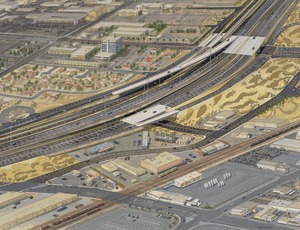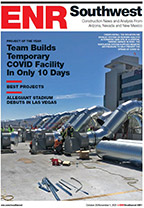
Nevada's Transportation Dept., which scrapped plans to use a public-private partnership (P3) approach for a massive and costly upgrade to a congested section of Interstate 15 in downtown Las Vegas, is turning to bond markets for financing. Higher interest rates, rising finance costs and increasing operation and maintenance expenses drove the Aug. 18 about-face, according to project officials.
 |
| Malfabon |
The Las Vegas' $1.5-billion Project NEON will now become a design-build job that places financing, maintenance and operation under state control. The project is geared to improve Nevada's busiest section of highway: a 3.7-mile stretch of I-15 between Sahara Avenue and the U.S. 95/I-15 interchange that sees 250,000 cars daily and 1,000 accidents annually.
The planned four-phase undertaking will reduce traffic weaving, improve safety and reduce congestion-related crashes, while providing additional capacity for future growth. Corridor traffic is expected to double by 2030.
Despite the burgeoning use of P3s in the U.S., only about 20 P3 design, build, finance, operate, and maintain projects have reached financial closure since 1990, partly due to regulatory and legislative hurdles and attractive tax-exempt municipal bonds, reports the Eno Center for Transportation, a Washington, D.C., nonpartisan think tank.
About 33 states have since adopted laws authorizing P3s for highway and bridge projects as "public revenue sources fall increasingly short" and the highway trust fund is plagued by funding shortages, says Joshua Schank, president and CEO.
Virginia officials recently decided not to pursue a P3 proposal led by Skanska Infrastructure Development Inc. and Kiewit Development Co. Inc. to build a Chesapeake Bay tunnel to parallel one of two existing subsurface structures along a 23-mile toll crossing.
Officials cited an absence of competing proposals that might yield a more competitive construction price and have opted to reprocure the project as design-build, much like Nevada's I-15 decision.
Project NEON will create a one-mile-long high-occupancy vehicle (HOV) connector between U.S. 95 and I-15, plus direct HOV access ramps. Work also includes reconstructing the Charleston Boulevard interchange and adding other new connections.
Construction is scheduled from 2015 to 2018, creating an estimated 4,100 jobs. Project NEON will reduce travel times by 22%, saving $110 million annually in lost productivity, according to officials.
The state had solicited P3 request-for-proposals in mid-2013, naming three finalist teams late last year: Kiewit Development Co. and Meridiam Infrastructure Neon LLC; Las Vegas Paving Corp. and Macquarie Capital Group Ltd.; and ACS Infrastructure Development Inc., Fengate Capital Management Ltd. and Star America Fund GP LLC.
Now, it's back to the drawing board for the teams after 13 months and millions spent on proposals. "We're back to square one, because it will be a different project," says Corey Newcome, Las Vegas Paving division manager.
The firm has spent roughly $2 million readying its project package. "We sensed something was amiss. The state has always struggled with private-sector operations and maintenance components," he says.
A new RFP is set to be issued within the next 30 days. The three teams are all expected to resubmit proposals, despite not being reimbursed for work performed to date. The state never issued a final RFP, thereby forgoing any obligation to pay a stipend. But state officials are meeting with the three finalists privately to address outstanding issues.
The revenue-backed 4.66% interest project bonds will be paid off by 2038, with payments on the principal deferred for four to five years due to preexisting debt service.
Bond issuance is being scheduled around ongoing rights-of-way purchases. The state began spending $250 million last year to buy land around the project alignment, but 100 parcels still need purchasing.
"The right-of-way acquisition schedule is the critical path for this project, not the procurement of the design-builder," Malfabon says. "The additional time it takes to repackage the RFP as a design-build project will not result in a delay, practically speaking, because we have a lot of private property left to acquire."


Post a comment to this article
Report Abusive Comment